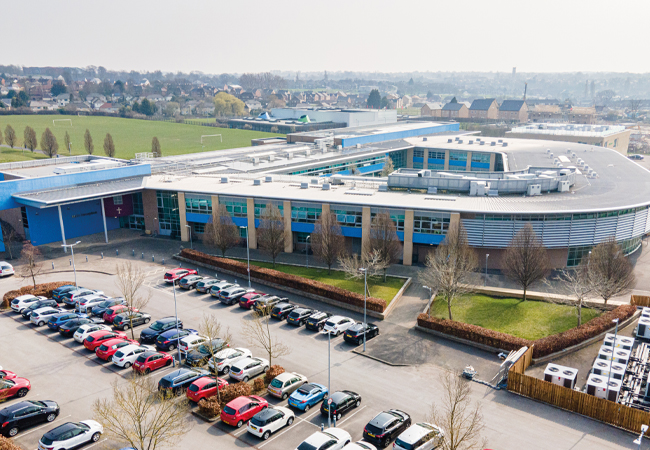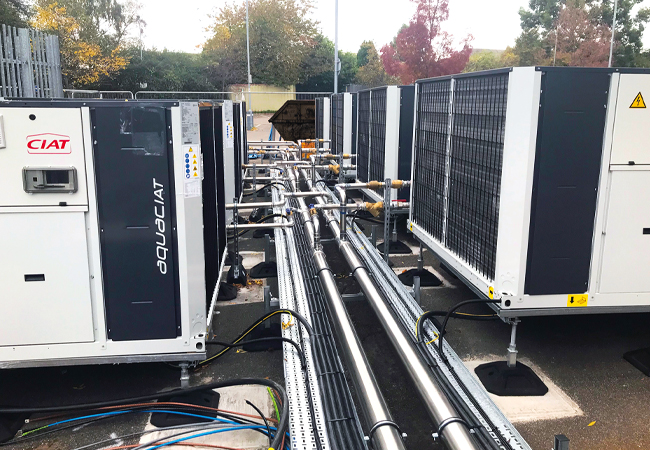
Even before the war in Ukraine’s impact on future gas prices, steep increases in energy costs were highlighting the urgent need for many organisations in the private and public sectors to reduce energy consumption, which, of course, goes hand in hand with reducing carbon emissions. A government initiative – the Public Sector Decarbonisation Scheme (PSDS) – offers the opportunity for organisations to get grant funding for heat decarbonisation and energy efficiency measures.
A £5m PSDS-funded project at the Abbey Multi Academy Trust (Abbey MAT), in Yorkshire – to replace existing gas boilers in five schools with a heat pump-based system – is an example that other education providers may be keen to follow. Installed over the summer holidays in 2021, the new system has eliminated the trust’s reliance on gas for space heating and hot water, and aims to reduce its carbon emissions by an estimated 9,000 tonnes over the 12-year lifetime of the scheme, saving an estimated £84,000 a year in energy costs.
The project involved the installation of 38 CIAT AquaCIAT TD300 air source heat pumps in the five schools, as well as LED lighting to reduce electricity consumption and solar photovoltaic (PV) arrays, designed by services specialist Robert Whetham Associates, that partly power the heat pump system. During the summer, when the school is closed, electricity produced by the PVs feeds into the Grid, providing an income for Abbey MAT.

Bishop
The trust aims to optimise system performance by adjusting flowrates and set points, to ensure comfortable indoor temperatures for students and staff throughout the day and over the year, as the seasons change.
One of the initial challenges for the project was the short timescale available to put together Abbey MAT’s grant application to Salix Finance, the PSDS scheme administrator. It required detailed proposals for each school to be collated within a two-week period because of delays in the process, tendering, and the logistics involved in getting contractors on site to do the work during the summer holidays. The trust worked with decarbonisation specialist Energy Management Group (EMG) to prepare the application.
Another key challenge was assessing the requirements for upgrading existing radiators to take account of the lower water temperatures delivered by the heat pumps. Detailed surveys were carried out by BREng Hull, in collaboration with EMG and Toshiba Carrier distributor Cool Designs.
‘We have done a lot of work on these type of projects, in terms of assessment and modelling classrooms, and that experience enabled us to meet the very tight timescale by applying our accumulated knowledge from those school projects to these buildings,’ says BREng Hull director Rob Smelt.
The school buildings ranged in age from the 1960s through to 2006, and the audit took account of the type and size of existing heat emitters, glazing, building fabric, room orientation, insulation and occupancy levels.
‘We had the details of recent fabric improvements, so we could evaluate room heat losses,’ says Smelt. ‘This enabled us to provide a rough estimate for tender purposes, based on what was in the room.’
The air source heat pump-based system connected largely to the school buildings’ existing infrastructure, such as pipework, radiators, fan convectors and air handling units. ‘The infrastructure didn’t have to change to deliver the same energy to the room, because we were still working at the same 10-degree temperature drop,’ says Smelt.
On the basis of the survey, however, around 50% of existing radiators were replaced with higher-capacity units or augmented with new units to achieve the required heating output.
Concentrating on improving the fabric to maintain classroom temperature wasn’t deemed the most cost-effective or efficient solution, according to BREng. It may also have created additional overheating issues, according to Smelt. ‘One of our thermal models proved that if you had a classroom with two outside walls, and it was double-glazed to a U-value of around 2.2-2.6, it has a gain of 1KW, even when it’s -4°C outside,’ he says. ‘If you tighten up thermal efficiency too much, it would result in temperatures of 28°C-29°C, even in March.’
Rather than using the SCOP figure, the team created a six-month profile for the period when the heating is used
That situation would necessitate cooling the rooms via natural ventilation, with a subsequent waste of energy, says Smelt.
Load profile
In terms of the new heat pump systems’ efficiency, the coefficient of performance (COP) at 7°C/6°C ambient temperature at 65°C flow/57°C return, was calculated at 2.7, while the seasonal COP (SCOP) was 3.29, based on the manufacturer’s performance figures for full load.
Rather than using the SCOP figure, however, the team created a six-month profile for the period when the heating is used, which it felt would create a better result for the schools’ requirements.
Specialist Andrew Gill, of Cool Designs, produced a run cost calculation based on average temperatures in the Leeds area for the past 10 years, focusing on the heating season. For these purposes, the team considered a simplified banded model that, for example, evaluated the duration of operation at 65°C flow temperature in winter, to pre-heat the buildings at low external temperatures; a transitional period for the initial hours of occupation; followed by the remainder of the day with a 50°C flow temperature (with the heating load part offset by internal gains). A similar exercise was applied across the remainder of the six months from October to April, to generate a load profile based on that part-load data at the different outdoor temperatures.
‘We felt that, by doing it this way, we arrived at a better result than using a seasonal COP,’ says Smelt. ‘We always assess our schemes at extreme, as well as typical, conditions to ensure we factor in real-life operational requirements – such as defrosting in winter – so the specification provides the appropriate space heating and hot water when needed.’
With different buildings across the five sites, various domestic hot water solutions have been implemented to suit each situation. One way directly employs a 65°C primary loop from the air source heat pumps being connected to the existing calorifier, while other methods include using a plate heat exchanger, linking the primary heated water to the calorifier or new cylinders with direct electric heaters.

38
The system is being fine-tuned to maintain 50°C-55°C temperatures, with legionella risk being monitored with the current planned preventive maintenance (PPM) at the taps. The PPM is not affected by the change to air source heat pumps, as regular automatic pasteurisation is implemented. Booster heaters on the hot water system are used to pasteurise stored water at night at 70°C two or three times a week, using 9kW electric heaters in the cylinders.
Fine-tuning of the systems at the converted schools has already begun. Each school is monitoring the performance of the system in terms of classroom thermal comfort, and adjusting individual systems by a few degrees as necessary.
The trust is developing an innovative school-wide heat map, produced using temperature data from new heat-sensitive fire alarm systems, with the idea of giving a real-time overview of actual conditions in each space across a school, so that set-points and flowrates from the heat pumps can be further optimised. Each school has either installed a new control panel with a building management system interface on each site or has adapted what was already there.
Smelt stresses the importance of the collaborative effort across disciplines that has enabled Abbey MAT to make the switch to a lower-carbon heating system. ‘Lots of different people that have worked together on this – and, like most projects, if you collaborate with each other you get the best outcomes.’


